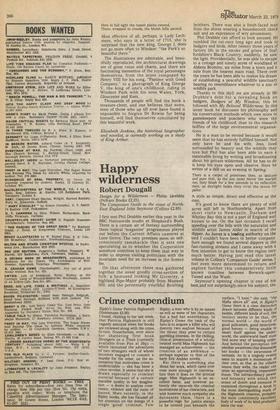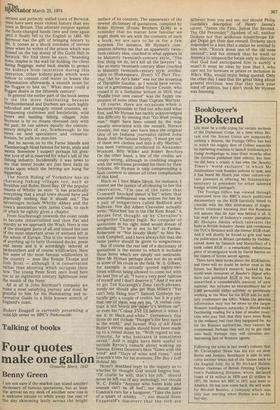Happy wilderness
Robert Dougall
Design for a Wilderness Philip Wabble (Pelham Books £2.25). The Companion Guide to the coast of NorthEast England John Seymour (Collins E2.95)
I first met Phil Drabble earlier this year in the BBC Nationwide studio at Shepherd's Bush. There is a certain air of fantasy surrounding these topical 'magazine' programmes played out before the Current Affairs cameras at Lime Grove. The very premises seem so selfconsciously ramshackle that it sets one speculating as to whether the Corporation somehow contrives to keep them that way in order to impress visiting politicians with the invariable need for an increase in the licence fee.
On that afternoon there was gathered together the usual goodly cross-section of folk: a bemused looking Mr Gormley, a highland Pipe-Major probably from Muswell Hill, and the perennially youthful Boulting
brothers. There was also a fresh-faced man from the shires wearing a houndstooth check suit and an expression of wry amusement.
Phil Drabble can afford to look amused. He rumbled the rat-race long ago and took to
badgers and birds. After twenty three years of factory life in the smoke and grime of Staffordshire's Black Country, suddenly, he saw the light. Providentially, he was able to escape to a cottage and ninety acres of woodland at Abbots Bromley, six miles from a town and a mile from the nearest main road. There over the years he has been able to realise his dream of establishing a peaceful wildlife sanctuary bearing no resemblance whatever to a zoo or wildlife park.
Thanks to this idyll we are already in Mr Drabble's debt for a revealing book on badgers, Badgers at My Window; this he followed with My Beloved Wilderness. In this latest book he discusses his philosophy and his conservation methods which owe more to gamekeepers and poachers who were the friends of his childhood, than to the research boffins of the large environmental organisations.
He is a man to be envied because it would seem that he has entirely fulfilled himself. Not only have he and his wife, Jess, lived surrounded by beauty and, the wildlife they love but Phil has also been able to earn a reasonable living by writing and broadcasting about his private wilderness. All he has to do IS keep his eyes open and observe. Here he writes of a dell on an evening in Spring: There is a carpet of primroses then, so delicate and pure that, as the sun sinks below the marlpit rim, they blush for a few seconds in its reflection; then, as daylight fades they rival the moon for pallor.
A style as simple, direct and effective as the man.
It's good to know there are plenty of wild acres still left in Northumbria. Apart from short visits to Newcastle, Durham and Whitley Bay this is not a part of England well known to me. On the last occasion I recall speeding over the fells with the naturalist and wildlife artist James Alder in search of the dipper. As James is a leading authority on the bird I couldn't have been in better company. Sure enough we found several dippers in the -fast-running streams and I came away with a firm intention to get to know the region very much better. Having just read this latest volume in Collins's 'Companion Guide' series, I feel even more determined to return and explore further this comparatively little known coastline between Berwick-uponTweed and the Wash.
Seymour's opening chapter is one of his best,and not surprisingly, since his subject, the
ancient and perfectly walled town of Berwick, must have seen more violent history than any town in Britain. This ultimate outpost against the Scots changed hands time and time again until it finally fell to the English in 1482. Mr Seymour has the gift of bringing history to life. It comes as a shock reminder of sterner times when he writes of the prison which was housed on the top storey of the Guild Hall in Berwick. We find there he says: "branding irons, staples in the wall for holding the client during floggings, metal back shields to protect the kidneys from laceration during this operation, other kidney-pads which were hollow to contain cold water to lessen the inflammation afterwards, a smooth stone for the floggee to bite on." What more could a floggee desire in the fifteenth century!
In general the earlier part of the book seems to me the more fascinating because Northumberland and Durham are such highly individual and strangely mixed counties, encompassing coalmines and battlefields, wild moors and bustling fishing villages. John Seymour is by no means obsessed only with the past: he can admire equally the contemPorary delights of, say, Scarborough. In his views on land speculators and conservationists, he pulls no punches.
But he moves on to the Fame Islands and Flamborough Head famous for birds, seals and saints. Somehow I suspect perhaps his greatest love of all is reserved for what's left of the fishing industry. Incidentally it was news to Me that tenter hooks are just bent nails on sticks upon which the herring are hung for kippering.
The North Riding of Yorkshire has its Charming fishing villages too, such as Straithes and Robin Hood Bay. Of the popular resorts of Whitby he says: "it has practically everything that a small town should have and Practically nothing that it should not." The advantages include Whitby Abbey and the town's association with James Cook, to each of which he rightly gives a chapter.
From Scarborough onwards the coast tends to become industrialised and then flat and Marshy as we approach the Wash. Here is one of the strangest parts of all,and inland lies one of the most important areas of wetland left in the whole of Europe. This is the winter home of anything up to forty thousand ducks, geese and swans and it is accordingly beloved of birdwatchers and of course wildfowlers. Here live some of the most famous wildfowlers in the country — men like Kenzie Thorpe and Josh Scott — although it is conservation rather than shooting which occupies them now. The young Peter Scott once lived here too in an eighteenth century lighthouse near the mouth of the Nene.
All in all in John Seymour's company we make a most satisfying journey and must be grateful to him for his illuminating and informative Guide to a little known stretch of England's coast.
Robert Dougall is currently presenting a' Wild-life series on BBC's Nationwide.



































 Previous page
Previous page